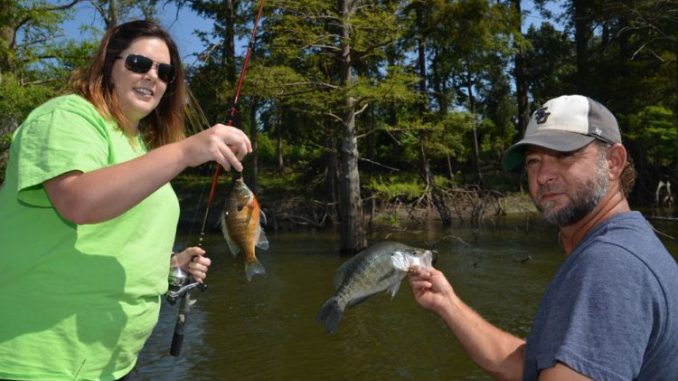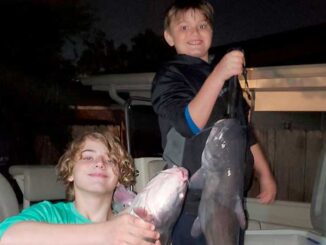
“Bream fishing in Old River is good from spring through October,” advised Padra Francois. “And the fishing is good. When people think of bream in Old River, they think of fish nearly a pound in weight.
“It’s good — I catch ‘em.”
For she and her husband Gene, the fishing cycle starts in April. At that time of the year, the lake is flooded by a Mississippi River swollen with spring runoff from half the United States. Backing in through a link to the river called the “Narrows” at the northeastern tip of the U-shaped lake, water levels can easily rise over 20 feet.
Francois begins her hunt for beds of spawning bream by searching on the island-side of the lake in its flooded dense forest. What locals call the island side is the lakeside on the inside of the arc-shaped lake. The land on the island side is a virtual wilderness named Raccourci Island.
In contrast, the other side of the lake (what she calls the levee side), is densely crowded with camps, including their own. It is paralleled closely by Highway 419 on the outside of the levee.
In their search for fish, they motor over the flooded ridges on the island side and cut their engine off to listen. If bream are present in any numbers, they can be heard ‘sucking’ on the top of the water as they feed.
Rather than there being just one ridge, a series of ridges and sloughs parallel the open water of the lake. The best beds are located on the first ridge.
Typically, these beds are located in 5 or 6 feet of water. In spite of this being backwater from the Mississippi River, it will stay clear enough to fish, unless extreme flooding conditions entirely inundate Raccourci Island and sheet flow from the river overwhelms it.
Padra targets the bases of the big trees on the ridge. “When you find them, you can catch five or you can catch 20,” she said. “Then you use your trolling motor to look for more.”
When the river and lake levels start dropping in early summer, the water will come off the ridges and the bream will follow it out. Fishing is best then in the midst of the cypress trees standing in the water, still on the island side of the lake.
By mid- to late summer, Padra and Gene shift their fishing effort to the deeper waters on the levee side of the lake — the side lined with camps. There, they target pilings, old piling posts, piers and privately owned floating rafts.
The pilings they target are in 12- to 14-foot depths. The rafts are mostly anchored in about 20 feet of water, ideal locations for their combo fishing.
The bream are usually suspended about 6 feet deep, and sac-a-lait will be found 1 foot off the bottom. When fishing deep water, what they define as 10 feet or deeper, they either tight-line or use sliding corks.
The couple sticks with this approach through October, unless the water rises enough to allow them to go back into the cypress trees on the island side.
After October, the bream bite slows considerably and by December, muddy Mississippi River backwaters have usually invaded the lake and make it uninviting for bream and sac-a-lait fishing.
They park their poles until April.
